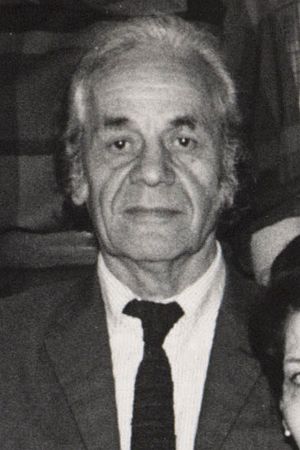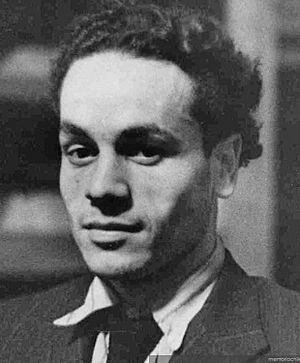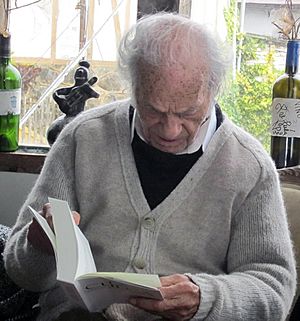Nicanor Parra facts for kids
Quick facts for kids
Nicanor Parra Sandoval
|
|
|---|---|
 |
|
| Born |
Nicanor Segundo Parra Sandoval
5 September 1914 |
| Died | 23 January 2018 (aged 103) La Reina, Chile
|
| Occupation | Poet |
| Awards | Miguel de Cervantes Prize (2011) |
Nicanor Segundo Parra Sandoval (born September 5, 1914 – died January 23, 2018) was a famous poet and scientist from Chile. Many people thought he was one of the most important Chilean poets writing in Spanish during the 1900s. He was often mentioned alongside another famous poet, Pablo Neruda. Parra called himself an "anti-poet." This was because he didn't like the usual fancy style of poetry. After reading his poems, he would sometimes say, "Me retracto de todo lo dicho," which means "I take back everything I said."
Contents
Life Story of Nicanor Parra
Nicanor Parra was born in 1914 in a place called San Fabián de Alico, near Chillán, in Chile. His father was a schoolteacher. Nicanor came from a very artistic family, the Parra family. Many of his family members were performers, musicians, artists, and writers. For example, his sister, Violeta Parra, was a well-known folk singer. His brother, Roberto Parra Sandoval, was also a folk singer.
His Education and Career
In 1933, Nicanor started studying at the University of Chile. He became a teacher of mathematics and physics in 1938. This was one year after he published his first book, Cancionero sin Nombre. After teaching in high schools in Chile, he went to the United States in 1943. He studied physics at Brown University. Later, in 1948, he went to Oxford University in England to study cosmology, which is the study of the universe.
Parra returned to Chile in 1952. He became a professor at the University of Chile. He taught theoretical physics there from 1952 to 1991. He also visited and taught at other universities, like Louisiana State University, New York University, and Yale University. He traveled to many countries, including England, France, Russia, Mexico, Cuba, and the United States, to read his poetry. He published many books throughout his life.
Meeting Famous Poets
When Nicanor was young, two very famous poets, Gabriela Mistral and Pablo Neruda, helped him. Gabriela Mistral noticed him when she visited Chillán. The national anthem was played for her because she was the first person from Latin America to win the Nobel Prize. After the anthem, Parra jumped onto the stage. He recited a poem he had written for her the night before. Mistral stayed standing until he finished. Later, she introduced him to important people in Santiago. She told them he would become a globally famous poet.
Later, Pablo Neruda helped Parra publish his book Poemas y Antipoemas in 1954. This book is considered a classic in Latin American literature. It is one of the most important Spanish poetry collections of the 1900s. American Beat writers, like Allen Ginsberg, said it inspired them.
His Final Years
Nicanor Parra passed away on January 23, 2018. He was 103 years old. He died in La Reina in Santiago de Chile.
Awards and Recognition
Nicanor Parra was suggested four times for the Nobel Prize in Literature. On December 1, 2011, Parra won the Cervantes Prize. This is the most important literary award in the Spanish-speaking world. On June 7, 2012, he also won the Pablo Neruda Ibero-American Poetry Award.
List of Works
- Cancionero sin nombre (Songbook without a Name), 1937
- Poemas y antipoemas (Poems and Antipoems), 1954
- La cueca larga (The Long Cueca), 1958
- Versos de salón (Parlor Verses), 1962
- Manifiesto (Manifesto), 1963
- Canciones rusas (Russian Songs), 1967
- Obra gruesa (Thick Works), 1969
- Los profesores (The Teachers), 1971
- Artefactos (Artifacts), 1972
- Sermones y prédicas del Cristo de Elqui (Sermons and Teachings of the Christ of Elquí), 1977
- Nuevos sermones y prédicas del Cristo de Elqui (New Sermons and Teachings of the Christ of Elquí), 1979
- El anti-Lázaro (The Anti-Lazarus), 1981
- Plaza Sésamo (Sesame Street), 1981
- Poema y antipoema de Eduardo Frei (Poem and Antipoem of Eduardo Frei), 1982
- Cachureos, ecopoemas, guatapiques, últimas prédicas, 1983
- Chistes parRa desorientar a la policía (Jokes to Confuse the Police), 1983
- Coplas de Navidad (Christmas Couplets), 1983
- Poesía política (Political Poetry), 1983
- Hojas de Parra (Grape Leaves / Pages of Parra (Spanish pun)), 1985
- Nicanor Parra: biografía emotiva (Nicanor Parra: Emotional Biography), 1988
- Poemas para combatir la calvicie (Poems to Combat Baldness), 1993
- Páginas en blanco (White Pages), 2001
- Lear, Rey & Mendigo (Lear, King & Beggar), 2004
- Obras completas I & algo + (Complete Works I and Something More), 2006
- Discursos de Sobremesa (After Dinner Declarations), 2006
- Obras Completas II & algo + (Complete Works II and Something More), 2011
- Así habló Parra en El Mercurio, entrevistas dadas al diario chileno entre 1968 y 2007 (Thus Spoke Parra in El Mercurio, Interviews Given to the Chilean Newspaper Between 1968 and 2007), 2012
- El último apaga de luz (The Last One to Leave Turns Off the Lights), 2017
English Translations of His Works
- Poems and antipoems, 1967
- Antipoems, new and selected, 1985
- Antipoems: How to Look Better and Feel Great, 2004
- After-Dinner Declarations, 2009
See also
 In Spanish: Nicanor Parra para niños
In Spanish: Nicanor Parra para niños



